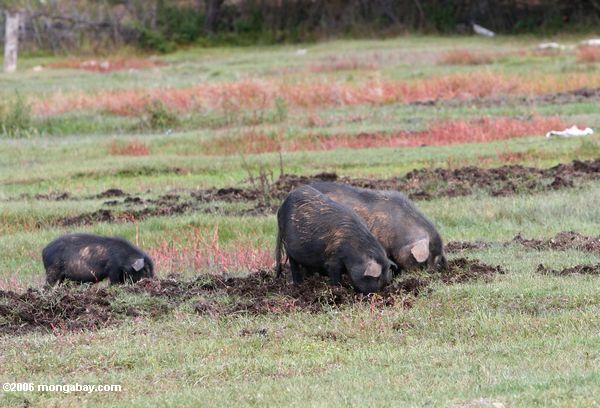Many landowners throughout the Southeastern United States hate the thought of having feral hogs on their property. Others love wild pigs because they are challenging to hunt. Sure, hogs in any area brings the potential for damage to crops, ranch facilities, livestock, and wildlife, but others view feral hogs as popular game species for hunters — and hog hunting can be tons of fun.
“Since 1539 when Hernando de Soto first introduced feral hogs to this country, and the mid-1600’s when the LaSalle expedition brought feral hogs to the Texas Gulf Coast, the population in that state alone has grown to an estimated 2 million head! About 20 other states also have feral hog populations.”
Worldwide, there are 23 subspecies of feral hogs are recognized. In many states, feral hogs are either domesticated hogs gone wild, Eurasion boars or a cross between the two. Texas, in fact, is one of the few states that may still have the pure strain of the Eurasian (Russian) boar.”

Some rural landowners, already battling to reduce feral hog populations using snares, traps or dogs, are seizing the opportunities that hunting allows. In fact, a 1993 survey by the Texas Agricultural Extension Service indicated that hog hunters paid $25-$1,000, or an average of $169, per hog hunt.
Hunting is concentrated in the areas with the largest hog populations: habitat such as dense pine woodlands, areas adjacent farm lands, and areas with dense brush cover with access to water. Feral hogs can make a living in a variety of habitats, so hog hunters can vary their method of take (gun, pistol, bow) depending on the situation.
Actually, hog hunting is especially popular among bowhunters and black powder hunters, although most feral hogs are taken with rifles, especially concurrent with the white-tailed deer hunting season.
But the biggest impact of feral hogs is how they displace native wildlife and compete for limited food resources. Plant communities only provide a certain amount of forage, so the introduction of feral hogs only increased competition for food. Feral hogs can have a negative impact on wildlife habitat, although in most cases it’s the battle for food and space that impacts native wildlife species the most.